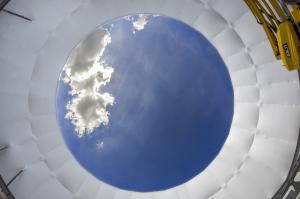Image of the week
Comfy cocoon
27 May 2019
The protective cocoon that encases the cryostat's lower cylinder briefly acquired some curves, last week, as air was pumped into it to test for potential leaks.
An unusual viewpoint of the protective cocoon that encases the cryostat lower cylinder, as air is being pumped into the 2,300 m³ volume to detect potential leaks.
Pressure inside the 2,300 m³ enclosure was raised to a few dozen pascals above atmospheric pressure, then lowered in the same proportion like in a breathing exercise.
The cocoon's synthetic skin passed the test, which guarantees that no leak or uncontrolled air intake, however small, will alter the quality of the atmosphere inside the structure.
In order to protect the lower cylinder from mould or corrosion, the air inside the cocoon will be kept circulating and maintained at a constant 38 percent humidity.


